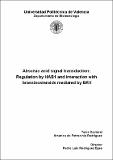Por favor, use este identificador para citar o enlazar a este item:
http://hdl.handle.net/10261/18827COMPARTIR / EXPORTAR:
 SHARE
BASE SHARE
BASE
|
|
| Visualizar otros formatos: MARC | Dublin Core | RDF | ORE | MODS | METS | DIDL | DATACITE | |

| Título: | Abscisic acid signal transduction: Regulation by HAB1 and interaction with brassinosteroids mediated by BRX |
Autor: | Rodrigues, Americo do Patrocinio | Director: | Rodriguez Egea, Pedro | Palabras clave: | Ácido abscísico Brasinoesteroides Arabidopsis HAB1 |
Fecha de publicación: | 2009 | Editor: | Universidad Politécnica de Valencia | Resumen: | The phytohormone abscisic acid (ABA) is a key regulator of plant growth and development as well as of plant responses to stress namely water and salt stresses. To gain further insight into ABA signaling and its role in growth regulation, we have screened for Arabidopsis thaliana mutants hypersensitive to ABA-mediated root growth inhibition. In this screen, we have identified a loss-of-function allele of BREVIS RADIX (BRX) in Columbia background, named brx-2. BRX encodes a key regulator of cell proliferation and elongation in the root, which has been implicated in the brassinosteroid (BR) pathway as well as regulation of auxin-responsive gene expression. Mutants affected in BR signaling that are not impaired in root growth, such as bes1-D, bzr1-D and bsu1-D, also showed enhanced sensitivity to ABA-mediated inhibition of root growth. Triple loss-of-function mutants affected in protein phosphatases type-2C (PP2Cs) that act as negative regulators of ABA signaling showed impaired root growth in the absence of exogenous ABA, indicating that disturbed regulation of ABA sensitivity impairs root growth. In agreement with this result, diminishing ABA-sensitivity of brx-2 by crossing it with a 35S:HAB1 ABAinsensitive line allowed significantly higher recovery of root growth after BL treatment. Finally, transcriptomic analysis revealed that ABA treatment negatively affects auxin signaling in wild type and brx-2 roots and that ABA response is globally altered in brx-2. Taken together, our results reveal an interaction between BRs, auxin and ABA in the control of root growth and indicate that fine tuning of ABA response might be required to prevent a deleterious effect on growth and development in the absence of environmental stress. ABA response is controlled by a complex network in which phosphorylation/dephosphorylation events have a very important role. HAB1 is a PP2C that plays a key role as negative regulator of ABA signaling; however, the molecular details of HAB1 action in this process are not known. A two hybrid screening revealed that AtSWI3B, an Arabidopsis homolog of the yeast SWI3 subunit of SWI/SNF chromatin remodeling complexes, is a prevalent interacting partner of HAB1. The interaction mapped to the N-terminal half of AtSWI3B and required an intact protein phosphatase catalytic domain. Bimolecular fluorescence complementation (BiFC) and coimmunoprecipitation (ChIP) assays confirmed the interaction of HAB1 and SWI3B in the nucleus of plant cells. Yeast two hybrid and BiFC assays also confirmed the interaction of SWI3B with ABI1, ABI2 and PP2CA, though this interaction was weaker than the observed with HAB1. swi3b mutants showed a reduced sensitivity to ABA mediated inhibition of seed germination and growth, and reduced expression of the ABA-responsive genes RAB18 and RD29B. ChIP experiments showed that the presence of HAB1 in the vicinity of RD29B and RAB18 promoters was abolished by ABA, which suggests a direct involvement of HAB1 in regulation of ABA-induced transcription. Contrary to the phenotypes presented by swi3b mutants, mutants of BRM and SYD, other putative members of Arabidopsis SWI/SNF complex, showed hypersensitivity to ABA in germination, root growth and enhanced expression of ABA responsive genes. Additionally, our results uncover AtSWI3B as a novel positive regulator of ABA signaling and suggest that HAB1 modulates ABA response through regulation of a putative SWI/SNF chromatin remodelling complex. | Descripción: | Tesis doctoral del Departamento de Biotecnología de la Universidad Politécnica de Valencia, realizada en el Instituto de Biología Molecular y Celular de Plantas | URI: | http://hdl.handle.net/10261/18827 |
| Aparece en las colecciones: | (IBMCP) Tesis |
Ficheros en este ítem:
| Fichero | Descripción | Tamaño | Formato | |
|---|---|---|---|---|
| Americo.pdf | 7,94 MB | Adobe PDF |  Visualizar/Abrir |
CORE Recommender
Page view(s)
473
checked on 23-abr-2024
Download(s)
1.951
checked on 23-abr-2024
Google ScholarTM
Check
NOTA: Los ítems de Digital.CSIC están protegidos por copyright, con todos los derechos reservados, a menos que se indique lo contrario.
